METABOLISME ENERGI DAN ZAT GIZI MAKRO PERTEMUAN 14

METABOLISME ENERGI DAN ZAT GIZI MAKRO PERTEMUAN 14 HENDRA WIJAYA-DUDUNG ANGKASA PROGRAM STUDI ILMU GIZI-FIKES

VISI DAN MISI UNIVERSITAS ESA UNGGUL

KEMAMPUAN AKHIR YANG DIHARAPKAN n Mahasiswa dapat menjelaskan transport, pemecahan, betaoksidasi, dan sirkulasi hasil betaoksidasi

PENGGUNAAN ENERGI DALAM KEADAAN ISTIRAHAT DAN LATIHAN HENDRA WIJAYA 4

The Chemistry of Energy Production n Energy in the human body is derived from the breakdown of complex nutrients like carbohydrates, fats, and proteins. n The end result of this breakdown is production of the adenosine triphosphate (ATP) molecule. n ATP provides energy necessary for body functions Breakdown of Energy currency Carbohydrates Fats Biochemical processes Muscular Work ATP Thermoregulation Digesting Food Proteins Sport Books Publisher 5

ATP Cycle Overview a) ATP breakdown b) Phosphorylation c) ATP resynthesis Sport Books Publisher 6

a) ATP breakdown (ATP turnover) ATP + H 2 O ADP + Energy + P 1. Hydrolysis of the unstable phosphate groups of ATP molecule by H 2 O 2. Phosphate molecule (P) is released from ATP (ATP ADP) 3. Energy is released (38 -42 k. J, or 9 -10 kcal/ mol ATP) Sport Books Publisher 7

b) Phosphorylation Molecule + P Energy for muscle contraction 1. Energy released by ATP turnover can be used by body when a free P group is transferred to another molecule (phosphorylation) Sport Books Publisher 8

c) ATP resynthesis ADP + Energy + P ATP 1. Initial stores of ATP in the muscles are used up very quickly and ATP must be regenerated 2. ATP is formed by recombination of ADP and P 3. Regeneration of ATP requires energy (from breakdown of food molecules) Sport Books Publisher 9

Human Energy Systems n ATP-PC System – adenosine triphosphate – phosphocreatine n Lactic Acid System – anaerobic glycolytic pathway n Oxygen System – aerobic metabolic pathways

The Energy Systems a) the high energy phosphate system (ATP-PC) 1. Adenosintriphosphate 2. Phosphocreatine b) the anaerobic glycolytic system (Lactic acid system) c) the aerobic oxidative system Sport Books Publisher 11

The Roles of the Three Energy Systems in Competitive Sport Books Publisher 12

Sport Books Publisher 13

The High Energy Phosphate System Overview Primary energy source: Stored ATP, CP Duration of activity: 7 -12 s Sporting events: Weight lifting, high jump, long jump, 100 m run, 25 m swim Advantages: Produce very large amount of energy in a short amount of time Limiting factors: Initial concentration of high energy phosphates (ATP, PC) Sport Books Publisher 14

ATP-PC Energy System ATP – Energy for muscle contraction


Training the High Energy Phosphate System a) Interval training: - 20% increase in CP (creatine phosphate) stores - no change in ATP stores - increase in ATPase function (ATP -> ADP+P) - increase in CPK (creatine phosphokinase) function (CPK breaks down CP molecule and allows ATP resynthesis) b) Sprint training: - increase in CP stores up to 40% - 100% increase in resting ATP stores Sport Books Publisher 17


The Anaerobic Glycolytic System Overview Primary energy source: Stored glycogen, blood glucose Duration of activity: 12 s – 3 min Sporting events: 800 m run, 200 m swim, downhill ski racing, 1500 speed skating Advantages: Ability to produce energy under conditions of inadequate oxygen Limiting factors: Lactic acid build up, H+ ions build up (decrease of p. H) Sport Books Publisher 19



The Anaerobic Glycolytic System Glycogen ENERGY Lactic Acid ADP + Pi ATP Sport Books Publisher 22

Glycolysis n n n A biochemical process that releases energy in the form of ATP from glycogen and glucose anaerobic process (in the absence of oxygen) The products of glycolysis (per molecule of glycogen): - 2 molecules of ATP - 2 molecules of pyruvic acid n The by-product of glycolysis (per molecule of glycogen): - 2 molecules of lactic acid Sport Books Publisher 23

Anaerobic Threshold The exercise intensity at which lactic acid begins to accumulate within the blood n The point during exercise where the person begins to feel discomfort and burning sensations in their muscles n Lactic acid is used to store pyruvate and hydrogen ions until they can be processed by the aerobic system n Sport Books Publisher 24

The Anaerobic Glycolytic System n cont . Starts when: – the reserves of high energy phosphate compounds fall to a low level – the rate of glycolysis is high and there is a buildup of pyruvic acid Sport Books Publisher 25

Substrates for the anaerobic energy system n n The primary source of substrates is carbohydrate Carbohydrates: – primary dietary source of glucose – primary energy fuels for brain, muscles, heart, liver Sport Books Publisher 26

Carbohydrate breakdown and storage Complex Carbohydrates Digestive system Glucose Blood Stream Circulation of glucose around body Glucose stored in blood Gluconeogenesis Glycogen stored in muscle or liver Sport Books Publisher 27

Effect of Training on the Anaerobic Glycolytic System n Rate of lactic acid accumulation is increased in the trained individual n This rate can be decreased by: a) reducing the rate of lactate production - increase in the effectiveness of the aerobic oxidative system b) increasing the rate of lactate elimination - increased rate of lactic acid diffusion from active muscles - increased muscle blood flow - increased ability to metabolize lactate in the heart, liver and in non-working muscle Sport Books Publisher 28


Oxygen Energy System

The Aerobic Oxidative System Overview Primary energy source: Glycogen, glucose, fats, proteins Duration of activity: > 3 min Sporting events: Walking, jogging, swimming, walking up stairs Advantages: Large output of energy over a long period of time, removal of lactic acid Limiting factors: Lung function, max. blood flow, oxygen availability, excess. energy demands Sport Books Publisher 31

Aerobic Oxidative System O 2 Glycogen Fat ENERGY Protein ADP + Pi ATP Carbon Dioxide Water Sport Books Publisher 32

The Aerobic Oxidative System The most important energy system in the human body n Blood lactate levels remain relatively low (3 -6 mmol/L bl) n Primary source of energy (70 -95%) for exercise lasting longer than 10 minutes provided that: n a) working muscles have sufficient mitochondria to meet energy requirements b) sufficient oxygen is supplied to the mitochondria c) enzymes or intermediate products do not limit the Kreb’s cycle n Primary source of energy for the exercise that is performed at an intensity lower than that of the anaerobic oxidative system Sport Books Publisher 33

09. 06 Aerobic Respiration Overview Slide number: 6 Glucose Glycolysis Pyruvate ATP NADH Acetyl-Co. A Krebs cycle NADH H 2 O ATP NADH yst s t r nspo a r t on Electr Plasma membrane em Mitochondrion Cytoplasm ATP Extracellular fluid CO 2 Copyright © The Mc. Graw-Hill Companies, Inc. Permission required for reproduction or display. O 2

The Oxidative Phosphorylation System n Two Pathways: Krebs Cycle & Electron Transport Chain n Biochemical process used to resynthesize ATP by combining ADP and P in the presence of oxygen n Takes place in mitochondrion (contains enzymes, co-enzymes) n Energy yield from 1 molecule of glucose is 36 ATP molecules n Energy yield from 1 molecule of fat up to 169 ATP molecules n By-products of this reaction: carbon dioxide, water Sport Books Publisher 35


INTERACTION OF ENERGY SYSTEMS Immediate Short-term Long-term

Energy Systems for Exercise Energy Systems Immediate: ATP - PCr (ATP & phosphocreatine) Short Term: Glycolytic (Glycogen-Lactic Acid) Long Term: Oxidative Mole of ATP/min Time to Fatigue 4 5 to 10 sec 2. 5 1 to 2 min 1 Unlimited time



Summary of the three energy systems Sport Books Publisher 41

The Role of Three Energy Systems During an All-out Exercise Activity of Different Duration Sport Books Publisher 42

Factors Affecting Physical Performance Sport Books Publisher 43

ENERGY REQUIREMENTS AND SOURCE OF ENERGY FOR SKELETAL MUSCLE ( Resting vs. Working)

ATP Use in the Resting Muscle Cell n ATP is necessary for cellular housekeeping duties, e. g. : – ATP is used for glycogenesis (storage form of glucose) – ATP is used to create another energy storage compound called creatine phosphate

Resting Muscle and the Krebs Cycle Resting muscle fibers typically takes up fatty acids from the blood stream. n Inside the muscle fiber, the FA’s are oxidized (in the mitochondria) mitochondria to produce Acetyl-Co. A & several molecules of NADH and FADH 2 n Acetyl-Co. A will then enter the Krebs cycle (in the mitochondria) mitochondria CO 2, ATP, NADH, FADH 2, and oxaloacetate n NADH and FADH 2 will enter the Electron Transport Chain. (in the inner mitochondrial membrane) synthesis of ATP n

Figure 10– 20 a

ATP use in Working Muscle n As we begin to exercise, we almost immediately use our stored ATP n For the next 15 seconds or so, we turn to the creatine-phosphate. This system dominates in events such as the 100 m dash or lifting weights.

Working Muscle n After the phosphagen system is depleted, the muscles must find another ATP source. n *The process of anaerobic metabolism can maintain ATP supply for about 45 -60 s. n Glycogen Glucose 2 pyruvic acid (2 ATP + 2 NADH) n 2 Pyruvic acid 2 lactic acid (2 NAD+) n Lactic acid diffuses out of muscles blood taken by the liver Glucose (by gluconeogenesis) blood taken by the muscle again * It usually takes a little time for the respiratory and cardiovascular systems to catch up with the muscles and supply O 2 for aerobic metabolism.

Muscle Metabolism Figure 10– 20 c

Anaerobic Metabolism, continued… Anaerobic metabolism is inefficient… Why? – Large amounts of glucose are used for very small ATP returns. – Lactic acid is produced whose presence contributes to muscle fatigue Which type of sports uses anaerobic metabolism? – Sports that requires bursts of speed and activity, e. g. , basketball.

Aerobic Metabolism n Occurs when the respiratory and cardiovascular systems have “caught up with” the working muscles. – Prior to this, some aerobic respiration will occur thanks to the muscle protein, myoglobin, which binds and stores oxygen. During rest and light to moderate exercise, aerobic metabolism contributes 95% of the necessary ATP. n Compounds which can be aerobically metabolized include: n – Fatty acids, Pyruvic acid (made via glycolysis), and amino acids.


Cori Cycle n Lactic acid is taken to the liver to be metabolized back into pyruvic acid and then glucose Glucose Lactate Blood Glucose Glycogen Blood Lactate Glucose Lactate Glycogen 54

Glucose alanine cycle

The Power Of The Aerobic System Evaluated by measuring the maximal volume of oxygen that can be consumed per kilogram of mass in a given amount of time n This measure is called aerobic power or VO 2 max (ml/min/kg) n Factors that contribute to a high aerobic power: n a) arterial oxygen content (Ca. O 2) - depends on adequate ventilation and the O 2 -carrying capacity of blood b) cardiac output (Q = HR x stroke volume) - increased by elevation of the work of heart and increased peripheral blood flow c) tissue oxygen extraction (a-v. O 2 diff) - depends upon the rate of O 2 diffusion from capillaries and the rate of O 2 utilization 56

The Substrates for the Aerobic System Carbohydrates ( glycogen and glucose) and fats (triglycerides and fatty acids) n Fats: n – found in dairy products, meats, table fats, nuts, and some vegetables – body’s largest store of energy, cushion the vital organs, protect the body from cold, and serve to transport vitamins – each gram of fat contains 9 calories of energy 57

58
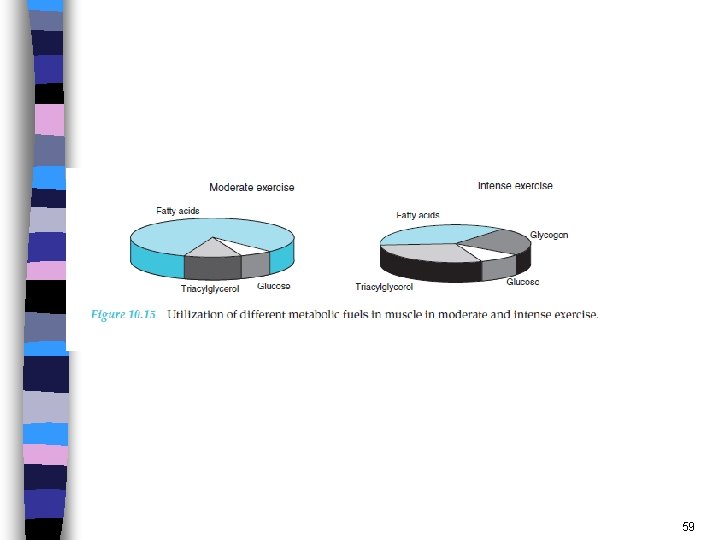
59

Effect of Training on Aerobic Systems n Endurance training is the most effective method (long duration several times per week): - increases vascularization within muscles - increases number and size of mitochondria within the muscle fibres - increases the activity of enzymes (Krebs cycle) - preferential use of fats over glycogen during exercise Endurance training increases the max aerobic power of a sedentary individual by 15 -25% regardless of age n An older individual adapts more slowly n Sport Books Publisher 60
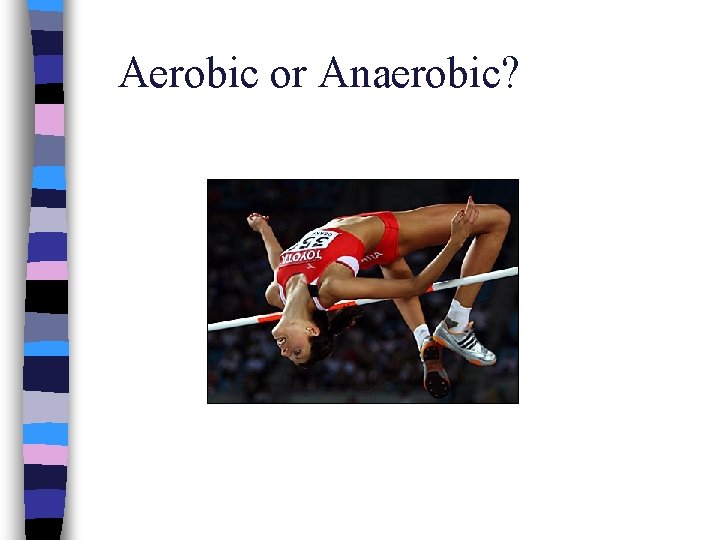
Aerobic or Anaerobic?

Aerobic or Anaerobic?
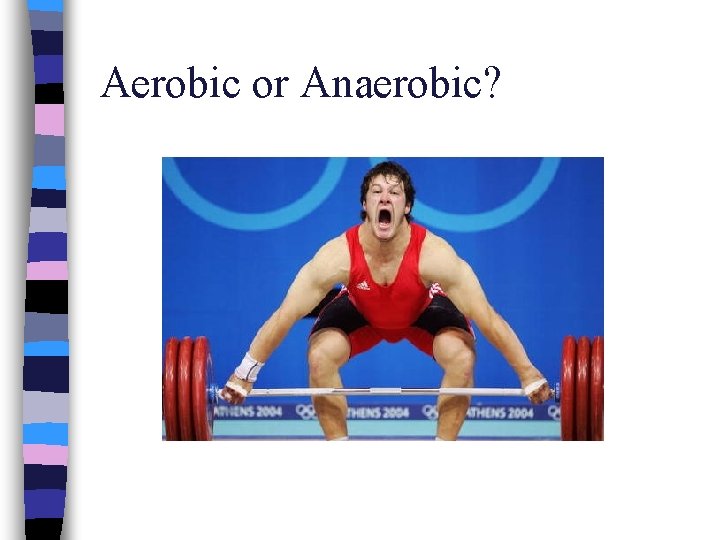
Aerobic or Anaerobic?

Aerobic or Anaerobic?
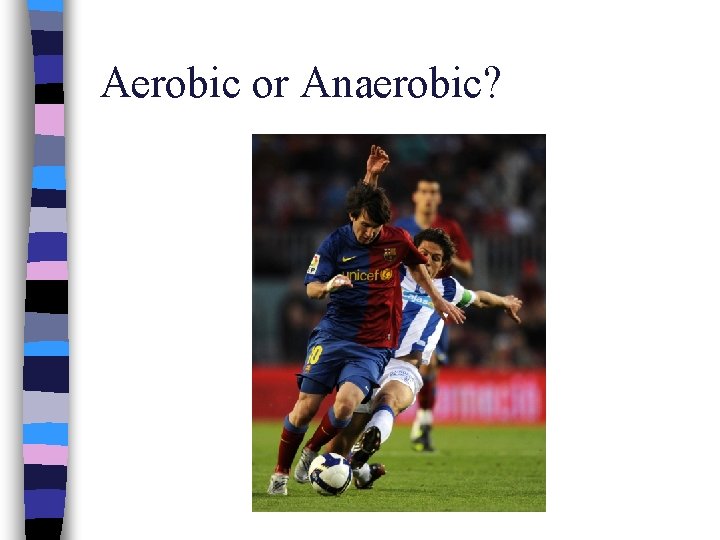
Aerobic or Anaerobic?

Aerobic or Anaerobic?
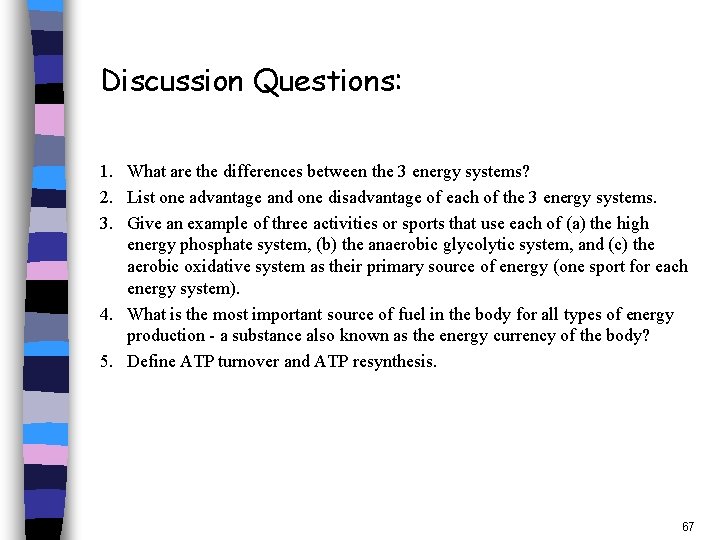
Discussion Questions: 1. What are the differences between the 3 energy systems? 2. List one advantage and one disadvantage of each of the 3 energy systems. 3. Give an example of three activities or sports that use each of (a) the high energy phosphate system, (b) the anaerobic glycolytic system, and (c) the aerobic oxidative system as their primary source of energy (one sport for each energy system). 4. What is the most important source of fuel in the body for all types of energy production - a substance also known as the energy currency of the body? 5. Define ATP turnover and ATP resynthesis. 67

68
- Slides: 68